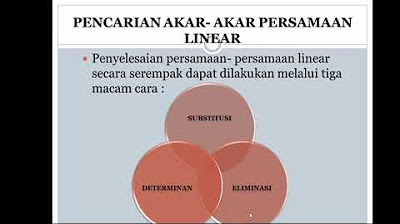Risolvere un'equazione di primo grado
Summary
TLDRThe video script offers a detailed walkthrough of solving a first-degree equation, specifically focusing on the variable Hicks. It emphasizes the importance of performing calculations on both sides of the equation, combining like terms, and isolating the variable. The process involves multiplying terms outside parentheses by those inside, moving terms with the variable to one side, and those without to the other, changing the sign as they move. The script concludes with dividing both sides by the coefficient of the variable to find its value. In this case, the solution to the equation is Hicks equals 6, providing a clear example of solving a linear equation step by step.
Takeaways
- 📚 The script discusses solving a first-degree equation, emphasizing the importance of understanding the structure of an equation with two expressions separated by an equals sign.
- 🔍 It defines the first member (left side of the equals sign) and the second member (right side) of the equation, highlighting that at least one of them contains a variable.
- ✅ The process of solving the equation involves performing calculations on both sides, simplifying terms, and isolating the variable.
- 🧮 It is mentioned that similar terms on each side of the equation should be combined to simplify the equation further.
- 🤔 The script provides a step-by-step guide on how to solve the equation, starting with performing calculations on both sides.
- 📝 It explains the need to move terms with the variable to one side of the equation and constants to the other, changing their signs in the process.
- 📊 The multiplication of terms outside parentheses with those inside is demonstrated, emphasizing the distributive property.
- 🧐 The transcript illustrates the process of combining like terms on both sides of the equation after performing the multiplication.
- 🔄 It is clarified that when moving terms from one side of the equation to the other, their signs must be reversed.
- ➗ Finally, the script describes dividing both sides of the equation by the coefficient of the variable to solve for its value.
- 🎓 The solution to the given first-degree equation is found to be hicks equals 6, after following the outlined steps.
- 📈 The script serves as a tutorial for individuals learning to solve linear equations, providing a clear methodological approach.
Q & A
What is the main topic of the transcript?
-The main topic of the transcript is solving a first-degree equation, specifically focusing on the steps to resolve it.
What is the first step in solving a first-degree equation according to the transcript?
-The first step is to perform calculations in both the left and right sides of the equation.
What does the transcript refer to as the 'first member' and 'second member' of the equation?
-The 'first member' refers to the part of the equation to the left of the equals sign, and the 'second member' refers to the part to the right of the equals sign.
How does the transcript describe the process of simplifying terms in the equation?
-The transcript describes simplifying terms by reducing similar terms separately in the first and second members and then moving all terms with the unknown variable to the first member and all known terms to the second member.
What is the purpose of moving terms from one side of the equation to the other?
-The purpose is to isolate the variable on one side of the equation, which is a step towards finding its value.
What is the significance of changing the sign when moving terms from one side of the equation to the other?
-Changing the sign is necessary to maintain the balance of the equation, as the term's contribution to the equation's sum changes when it is moved.
What does the transcript indicate as the final step in solving the equation?
-The final step is to divide both members of the equation by the coefficient of the unknown variable to find its value.
What is the solution to the first-degree equation presented in the transcript?
-The solution to the equation is hicks equals 6.
How does the transcript handle terms within parentheses during the equation-solving process?
-The transcript advises to multiply the term outside the parentheses by each term inside the parentheses, taking care to distribute the multiplication correctly.
What is the role of the unknown variable in the context of the transcript?
-The unknown variable, represented as 'hicks' in the transcript, is the element of the equation that the process aims to solve for, by isolating it and determining its value.
Why is it important to combine like terms during the equation-solving process?
-Combining like terms simplifies the equation and makes it easier to solve by reducing the number of variables and constants that need to be dealt with separately.
How does the transcript ensure that the equation remains balanced during the solving process?
-The transcript ensures balance by applying the same operations to both sides of the equation and by changing the sign of terms when they are moved from one side to the other.
Outlines

This section is available to paid users only. Please upgrade to access this part.
Upgrade NowMindmap

This section is available to paid users only. Please upgrade to access this part.
Upgrade NowKeywords

This section is available to paid users only. Please upgrade to access this part.
Upgrade NowHighlights

This section is available to paid users only. Please upgrade to access this part.
Upgrade NowTranscripts

This section is available to paid users only. Please upgrade to access this part.
Upgrade NowBrowse More Related Video
5.0 / 5 (0 votes)





